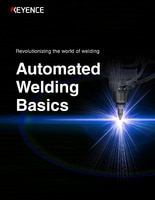Soldering
In brazing and soldering, soldering is the joining method that uses filler materials with low melting points. Whereas brazing uses a laser, soldering uses a light beam as the heat source. This page introduces this method, which is often used for detailed joining work.
Normal soldering uses heat produced by an electric current such as a soldering iron. Other soldering methods include dip soldering and reflow soldering, in which the components are joined by immersing them in molten solder.
In recent years, however, light beam soldering has been adopted for the production of electronic components in factory automation.
Light generated from a high-power light source is collected by a reflector and focused on the part to be welded, where soldering is performed using the energy of the light. Because this process uses solders (soft filler materials) with low melting temperatures and allows the use of robots for precise joining, it is useful for assembly automation and mass-production of heat-sensitive electronic components.
Soldering can be broadly classified into three techniques.
Trowel soldering
A trowel heated by a nichrome heater or other source is used to melt the solder and join base materials. Depending on the structure of the heater used, trowels are either nichrome heater or ceramic heater types.
Nichrome heater types boast a large heat capacity and are suitable for joining metals. With ceramic heater types, the tip of the trowel is heated by a tungsten heater wrapped in ceramic. This type offers excellent insulation properties, making it suitable for soldering delicate electronic parts such as integrated circuits.
Dip soldering
With dip soldering, joining is done by dipping the part to be soldered into molten solder. Dip soldering requires careful control of the temperature in the solder bath as well as the concentration of impurities in the solder itself.
Reflow soldering
Reflow soldering is mainly used for mounting surface-mounted components (SMD) on PCBs. Solder paste is printed on the bonding area (land) of the PCB, and electronic components are mounted to this area. The PCB is then sent to a reflow furnace where the solder is melted with infrared rays or hot air.
For the heat source, methods include using hot air inside the furnace and using infrared rays. Electric resistance or lasers can also be used as the heat source.




